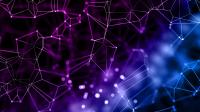Why did a physicist win the Nobel Prize for neural networks?
Julian Sienkiewicz, PhD, and Tomasz Gradowski, PhD, from the Faculty of Physics, along with Prof. Przemysław Biecek, PhD, from the Faculty of Mathematics and Information Science, commented on the awarding of the Nobel Prize in Physics.
Why did a physicist win the Nobel Prize for neural networks?
Comment by Julian Sienkiewicz, PhD, and Tomasz Gradowski, PhD, from the Faculty of Physics:
Many were surprised by the decision of the Nobel Committee to award the prize in physics to John Hopfield and Geoffrey Hinton for "fundamental discoveries and inventions enabling machine learning through artificial neural networks." While the choice of Hinton, known as the godfather of AI due to his work on backpropagation in multi-layer neural networks, was expected, the award for Hopfield, a physicist, raised eyebrows.
Yet it was Hopfield who in 1982 published a paper in PNAS titled Neural Networks and Physical Systems with Emergent Collective Computational Abilities, showing that the description of a single-layer neural network is identical to a model proposed for spin glass. Spin glass, studied by David Sherrington and Scott Kirkpatrick in 1975 and later by Nobel laureate Giorgio Parisi (Physics 2021), refers to systems characterized by a lack of overall magnetic moment but exhibiting local spin order. Hopfield demonstrated that his neural network model, which simulated associative memory, could store and recall patterns through collective interactions between neurons.
This work marked a milestone in the development of recurrent neural networks, now used in handwriting recognition, speech processing, and natural language processing. Today, neural networks are standard tools in physics, applied in particle identification, optical element design, and the prediction of connections in social networks.
Although over 40 years have passed since Hopfield's work, the feedback loop between physics and computer science continues. Recent advancements, such as PINNs (Physics-Informed Neural Networks), have enabled neural networks to solve physical problems by incorporating basic physics principles into their cost functions.
What does this year's Nobel Prize in Physics teach us?
Comment by Prof. Przemysław Biecek, PhD, from the Faculty of Mathematics and Information Science:
Artificial intelligence is becoming an integral part of our lives. The moment when its impact would be recognized with a Nobel Prize was inevitable, and it came in October 2024 with the award to John Hopfield and Geoffrey Hinton.
This choice sparked controversy, especially regarding Hinton, who is not a "typical physicist." His major achievement—Boltzmann machines—is not related to elementary particle physics or solid-state physics but is an AI algorithm inspired by physics, used for pattern recognition in data.
Additionally, Hinton's groundbreaking work was not published in a prestigious physics journal but in Cognitive Science, a journal valued at 100 points in Poland (equivalent to a "satisfactory" grade), not even classified within the physical sciences.
So, what actually happened? Did the Nobel Committee get caught up in the AI hype, or are the traditional distinctions between disciplines becoming obsolete? Perhaps the real discoveries, those that change our world, occur at the boundaries of disciplines, far from academic silos.
Science in Poland is experiencing a major crisis, both in identity and funding. We celebrate the achievements of scientists with Polish roots, but we fail to create an environment where such breakthroughs can happen at Polish universities.
This year's Nobel Prize in Physics has taught me two simple truths: investing in basic research pays off and can lead to breakthrough technologies like AI. Working in disciplinary silos and fearing to cross their boundaries are limitations we must overcome.
Long live interdisciplinarity. Long live progress. Long live physics!








